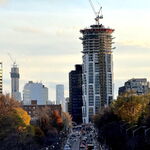Request for Qualifications Issued for Union Station Enhancement Project
February 23, 2017
TORONTO - Infrastructure Ontario (IO) and Metrolinx have issued a Request for Qualifications (RFQ) for interested parties to design, build and finance the Union Station Enhancement project. The infrastructure upgrades are required to accommodate the planned expansion of GO Transit rail service, which link into Union Station as the major transit hub in the City of Toronto.
The RFQ outlines the scope of work required, which includes:
- Construction of a new platform, including a new roof structure
- Development of a new concourse area below the platform
- Safety and state of good repair works within the train shed
- A new emergency power system
This project is part of Metrolinx's work in support of GO Regional Express Rail (RER). GO RER will provide faster, more frequent and more convenient transit service across the Greater Toronto and Hamilton Area (GTHA), including electrification of core segments of the GO rail network by 2024-25. The program will provide new travel choices for commuters, significantly increase transit ridership, cut journey times and help manage congestion across the Greater Toronto and Hamilton Area.
Major infrastructure updates are required to bring this level of service to communities across the region, including: adding track, modifying GO stations, improving rail crossings, building required systems for electrification and adding new locomotives and train control systems.
The RFQ is the first step in the procurement process to select a team to deliver the project. IO and Metrolinx will evaluate submissions to prequalify project teams with the relevant design and construction experience. Teams that qualify will be invited to respond to a request for proposals, which is expected to be issued in summer 2017. Interested companies must register with
www.merx.com to download the RFQ.
[...]
Quotes:
“These improvements to Union Station are necessary steps that will support our expansion of GO Transit service across the network. By improving service and providing people with more transit options, we are managing congestion, creating jobs and making your commute faster than ever before.”
Steven Del Duca, Minister of Transportation
“The Union Station Enhancement project, which features a new platform and enables expanded GO Transit service, will benefit thousands of commuters by offering more frequent trains and a quicker ride to work or home. Those in communities across the Greater Toronto and Hamilton Area (GTHA) can cut car trips and increase their transit ridership, helping to reduce traffic congestion and contributing to shorter delivery times for companies moving their products or providing services using busy GTHA highways.”
Bob Chiarelli, Minister of Infrastructure
“The Union Station Enhancement project will make marked improvements to Union Station that allow for us to proceed with the Regional Express Rail transformation, bringing residents of the Greater Toronto and Hamilton Area a faster and more efficient way to travel.”
Bruce McCuaig, President and CEO, Metrolinx
“The Union Station Enhancement project is an important component to help deliver the RER program. IO looks forward to reviewing the RFQ submissions by the market for this project.”
Ehren Cory, Divisional President, Project Delivery, Infrastructure Ontario
[...]






